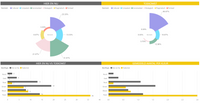Research
How does educational culture relate to ‘student ownership of learning’?
Introduction
In the research conducted by Stichting SOL (Foundation for Student Ownership of Learning), the outcomes of a game-based method are linked to how students experience ownership of their learning. From the beginning, our core question has been: Which cultural aspects within a school foster ownership of learning? Over the years, standardized tools have been developed and a rich database has been built. Below you’ll find a short explanation of the theoretical background and our approach.
Theoretical Framework
A Taxonomy of School Cultures
At the heart of our approach lies a taxonomy of six school cultures, based on the work of John MacBeath (2005) and adapted to the perspective of student ownership:
- Formal school – traditional and hierarchical
- Pragmatic school – warm, informal, and ad-hoc organized
- Strategic school – systematic and plan-based
- Incremental school – consciously working to increase ownership
- Empowered school – shared ownership, recognition for all
- Cultural school – deeply embedded, sustainable shared ownership
The WOTS Game
Based on this taxonomy, SOL developed the board game We Own The School (WOTS). This game invites all school stakeholders – from students to school board members – to explore the current and desired culture of their school together. The game provides valuable data for school development.
The Five-Layer Model of Ownership
Ownership of learning is a layered and complex concept. SOL developed a model of five concentric layers, each representing a different dimension of ownership. The taxonomy of school culture belongs to Layer D: the school context.
The Survey
The Personal Experience of Ownership.
In addition to the game, SOL developed a second tool: a survey focused on Layer A: the personal experience of students.
While the game reveals how students perceive the school culture, the survey zooms in on how they experience their own ownership of learning. It explores six indicators:
- Flow
- Creativity
- Constructive learning
- Intrinsic motivation
- Sense of responsibility
- Psychological ownership
The results are visualized in profile graphs. By repeating the survey over time, growth and development can be tracked.
Benchmark and Data
Survey results are presented in clear, visual data overviews. The outcomes reveal what type of ownership students experience. Schools can retake the survey later to compare results and assess changes over time. SOL is building a benchmark based on this data, enabling schools to compare themselves with others in a fully anonymous way. Only aggregated data are used.
Implementation
The survey is conducted digitally via Google Forms. Students receive a link, complete the questionnaire, and the school receives a report including:
- Averages per school, learning track, and grade
- Charts showing scores on the six indicators
- Introductory text with student quotes (to clarify questions)
Layer A: The Core Experience
Ultimately, any intervention in school culture aims to improve Layer A: the student’s experience of ownership. That’s why SOL, based on literature and research, developed a coherent set of indicators that describe ownership as learning that deeply belongs to the learner.
The six indicators are carefully selected from various theoretical sources and form a research-based, practice-tested tool that is ready to use.
Research Question
The central research question is: What is the relationship between different school cultures and students’ experience of ownership of learning?
In other words: how does Layer D (school culture) affect Layer A (the learner’s experience)?
SOL has already collected substantial data on Layer D and is now actively gathering data on Layer A. Connecting these two layers is the next step in our research.


